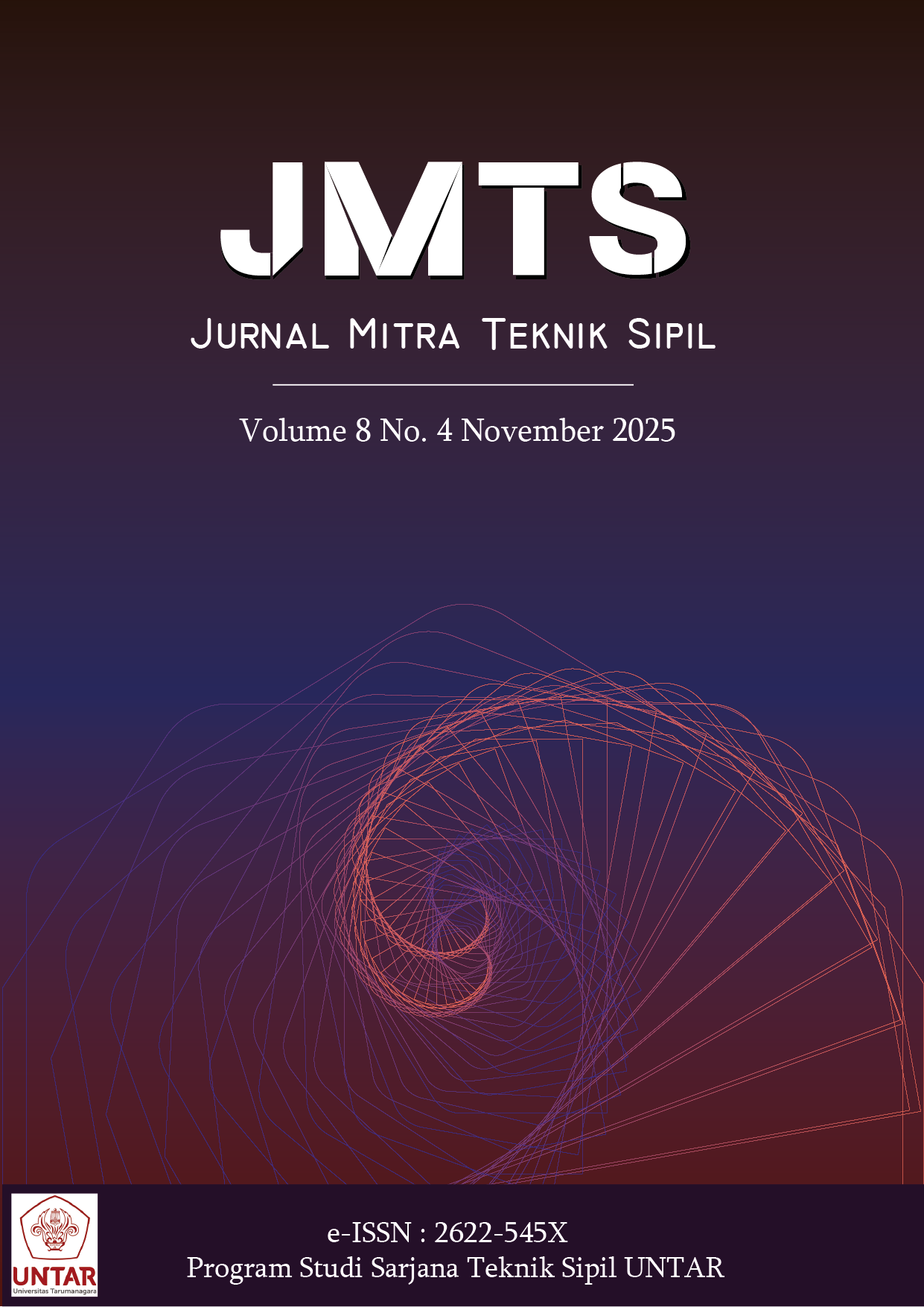INOVASI PENGAWETAN TULANGAN BAMBU MENGGUNAKAN ASAM SULFAT UNTUK MENINGKATKAN KINERJA BALOK BETON BERKELANJUTAN
Main Article Content
Abstract
Environmental concerns caused by the use of conventional construction materials have encouraged the development of sustainable alternatives, including bamboo. However, the durability of bamboo as concrete reinforcement remains limited due to its hygroscopic nature and biological degradation. This study aims to evaluate the effectiveness of bamboo preservation using a 1.2% sulfuric acid solution in enhancing the tensile strength of bamboo and the flexural capacity of reinforced concrete beams. The method employed was a laboratory experiment with three reinforcement variations: plain steel bars (BK), bamboo soaked in water (BT-BA), and bamboo treated with sulfuric acid (BT-BAS). Tensile and flexural tests were conducted for each variation. The results showed that the tensile strength of bamboo increased from 299.48 MPa (BT-BA) to 358.12 MPa (BT-BAS), indicating a 19.6% improvement. In the flexural test, BT-BAS beams reached an average nominal moment of 6.14 kNm, with a flexural capacity ratio of 107.15% compared to analytical results. These findings demonstrate that sulfuric acid preservation significantly enhances both the mechanical properties of bamboo and the structural performance of concrete beams. Thus, sulfuric acid–treated bamboo presents strong potential as a sustainable alternative reinforcement in structural applications.
Abstrak
Permasalahan lingkungan akibat penggunaan material konstruksi konvensional mendorong pengembangan bahan alternatif yang berkelanjutan, salah satunya adalah bambu. Namun, daya tahan bambu sebagai tulangan beton masih terbatas karena sifat higroskopis dan degradasi biologis. Penelitian ini bertujuan untuk mengevaluasi efektivitas pengawetan bambu menggunakan larutan asam sulfat 1,2% terhadap peningkatan kekuatan tarik bambu dan kapasitas lentur balok beton. Metode yang digunakan adalah eksperimen laboratorium dengan tiga variasi tulangan: baja polos (BK), bambu direndam air (BT-BA), dan bambu direndam asam sulfat (BT-BAS). Uji tarik tulangan dan uji lentur balok dilakukan pada masing-masing variasi. Hasil menunjukkan bahwa kuat tarik tulangan bambu meningkat dari 299,48 MPa (BT-BA) menjadi 358,12 MPa (BT-BAS), atau meningkat sebesar 19,6%. Pada pengujian lentur, balok BT-BAS menghasilkan momen nominal rata-rata 6,14 kNm dengan rasio kapasitas lentur 107,15% terhadap hasil analisis. Hal ini membuktikan bahwa metode pengawetan dengan asam sulfat tidak hanya meningkatkan sifat mekanis bambu, tetapi juga meningkatkan performa balok beton secara signifikan. Dengan demikian, bambu yang diawetkan dengan asam sulfat berpotensi sebagai alternatif tulangan ramah lingkungan dalam konstruksi struktural.
Article Details

This work is licensed under a Creative Commons Attribution-NonCommercial-ShareAlike 4.0 International License.
This work is licensed under Jurnal Mitra Teknik Sipil (JMTS) Creative Commons Attribution-ShareAlike 4.0 International License.References
Amada, S., Ichikawa, Y., Munekata, T., Nagase, Y., & Shimizu, H. (1997). Fiber texture and mechanical graded structure of bamboo. Composites Part B: Engineering, 28(1), 13–20. doi: https://doi.org/10.1016/S1359-8368(96)00020-0
Andriani, C., & Putra, H. A. (2022). Sifat mekanik bambu sebagai bahan konstruksi. TEKSTUR: Artikel Arsitektur, 3(1), 37–46. doi: 10.31284/j.tekstur.2022.v3i1.2843
Badan Standar Nasional. (2019). Persyaratan beton struktural untuk bangunan gedung (SNI 2847:2019). http://sispk.bsn.go.id/SNI/DaftarList
Chen, S., Wang, Z., Fang, K., Fan, G., Peng, W., & Song, J. (2014). Impact of dilute sulfuric acid pretreatment on fermentable sugars and structure of bamboo for bioethanol production. BioResources, 9(4), 7636–7652. doi: https://doi.org/10.15376/biores.9.4.7636-7652
Haixia, Y., Manping, X., Wenfu, Z., Xiaowei, Z., Jin, W., & Xin, P. (2021). Method for reinforcing and enhancing bamboomwood materials (US 20210138684A1). United States: United States Patent Application Publication .
Kusumaningrum, W. B., Rochmadi, R., & Subyakto, S. (2017). Pembuatan selulosa terasetilasi dari pulp bambu betung (dendrocalamus asper) serta pengaruhnya terhadap sifat mekanis polipropilena. Reaktor, 17(1), 25. doi: 10.14710/reaktor.17.1.25-35
Luo, Y., Chen, Y., & Yu, Y. (2025). Mechanical and impermeability properties of bamboo fiber reinforced concrete before and after wet-dry cycling. Structures, 73, 108363. doi: https://doi.org/10.1016/j.istruc.2025.108363
Lempang, M. (2016). Pengawetan bambu untuk barang kerajinan dan mebel dengan metode tangka terbuka. Info Teknis EBONI, 13(2), 79–92. doi: 10.20886/buleboni.5081
Tumonglo, N. Y., Ridwan, & Yacub, N. (2020). Pengawetan bambu dengan menggunakan larutan boraks boriks. SAINTIS, 1(2). Retrieved from file:///C:/Users/asus/Downloads/124-File%20Utama%20Naskah-613-1-10-20211016%20(1).pdf
Othman, H., Ebrahim, S., Reda, E., Mamdouh, F., Yousif, Aِِِ., & Hassabo, A. (2024). Focus on bamboo and its physical, chemical properties, and dyeing methods. Journal of Textiles, Coloration and Polymer Science, 0(0), 0–0. doi: 10.21608/jtcps.2024.258886.1261
Padang, I., Honta, Z. L., & Manga, J. (2024). Kuat lentur balok beton yang menggunakan batang pohon aren sebagai tulangan. Prosiding Konferensi Nasional Teknik Sipil ke 18. 2(3). https://doi.org/10.62603/konteks.v2i3.169
Pamona S. Sinaga, Mamie E. Pelloundo’u, Nixon Rammang, Roni H.Sipayung, & Marlince Manehat. (2024). Perbandingan metode pengawetan asap cair dan perebusan boraks terhadap kualitas 3 jenis bambu. INNOVATIVE: Journal Of Social Science Research, 4(3), 1165–1174. Retrieved from https://j-innovative.org/index.php/Innovative
Permatasari, H. R., Gulo, F., & Lesmini, B. (2014). Pengaruh konsentrasi H2SO4 dan NaOH terhadap delignifikasi serbuk bambu (gigantochloa apus). Jurnal Penelitian Pendidikan Kimia, 1(2), 131–140. Retrieved from https://core.ac.uk/download/pdf/267822919.pdf
Pertiwi, B., & Atul, M. I. (2025). Penggunaan material bambu sebagai bahan utama konstruksi pada bangunan green village bali. Filosofi: Publikasi Ilmu Komunikasi, Desain, Seni Budaya, 2(1), 27–35. doi: 10.62383/filosofi.v2i1.458
Putri, R. L., Rochmawati, L., Nandika, D., & Darmawan, I. W. (2020). Pengawetan bambu dengan metode boucherie. Jurnal Ilmu Pertanian Indonesia, 25(4), 618–626. doi: 10.18343/jipi.25.4.618
Ramaani, P., Rajan, S., & bose S, G. (2025). Eco-innovations in construction: Experimental study on bamboo reinforcement for sustainable building solutions. Results in Engineering, 105217. doi: 10.1016/j.rineng.2025.105217
Rathod, S., Parab, A., Tamkhane, A., & Neharkar, A. (2022). A comparative study of bamboo reinforced vs steel reinforced concrete structure. International Journal for Research in Applied Science and Engineering Technology, 10(12), 973–976. doi: 10.22214/ijraset.2022.48070
Refiadi, G., Siti Syamsiar, Y., & Judawisastra, D. H. (2018). Sifat komposit epoksi berpenguat serat bambu pada akibat penyerapan air. In Jurnal Sains Materi Indonesia. 19(3). https://doi.org/10.17146/jsmi.2018.19.3.4289
Sain, A., Gaur, A., Khichad, J. S., & Somani, P. (2024). Treatment of bamboo for sustainable construction practise: A comprehensive review. IOP Conference Series: Earth and Environmental Science, 1326(1). doi: 10.1088/1755-1315/1326/1/012049
Izza, W. N. (2025, April 28). Material konstruksi berkelanjutan: Solusi masa depan untuk industri bangunan. Diklatkerja.Com.
Walter, L. (2015). Bamboo: The plant and its uses (K. Michael, Ed.). Springer.



